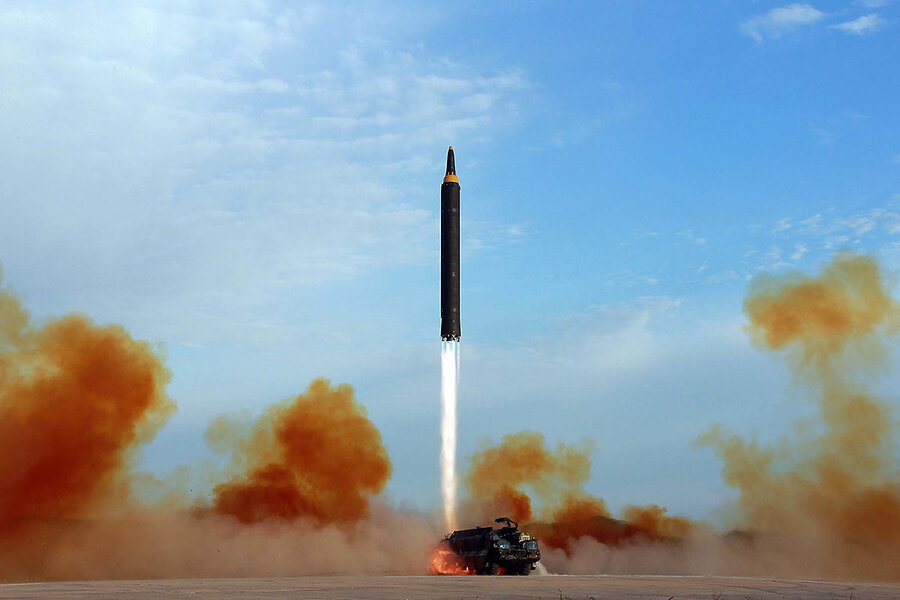Why did North Korea suddenly start testing missiles again?
Loading...
It’s a bit of a mystery: Why did North Korea take a two-month time out from testing missiles?
On Tuesday, Pyongyang launched a ballistic missile from South Pyongan Province, according to South Korea’s military. Officials did not immediately disclose any information about missile type. They said only that it traveled to the east.
But prior to that, North Korea’s last test launch was in mid-September. It tested at a rapid pace in the summer – seven launches from July through the end of August. Then, for two months, zip, nada. The launch pads were quiet until today.
It’s tempting to speculate about possible geopolitical reasons for this pattern. Perhaps President Trump’s rhetoric, such as his vow to use “fire and fury” to counter North Korean nuclear threats, gave Pyongyang pause, and they took time to rethink the issue. Perhaps China leaned on North Korea – finally – to rein in its impetuous behavior.
Then Mr. Trump relisted North Korea as a state that sponsors terrorism. The United States added some new sanctions to squeeze the already-constrained North Korean economy. North Korea leader Kim Jong-un felt he had to respond. The result: Tuesday’s launch.
Perhaps – but it’s more likely the pause has practical causes, say experts. In recent years, North Korea has generally tested few missiles in the fourth quarter of the year. Occasionally, it launches one or two. But generally there is no rapid pace at the end of the year.
“North Korea tests its missiles when it’s ready to. They’ve got a program in place that probably has a schedule and a timetable for deliverables,” says Shea Cotton, a research associate at the James Martin Center for Nonproliferation Studies at the Monterey Institute of International Studies in Monterey, Calif., in an email.
Mr. Cotton is an expert in open source intelligence who has built and runs a North Korean Missile Test Database. He is also part of a team that uses satellite images and modeling techniques to geo-locate North Korea’s missile test and nuclear sites, and even the exact location of Kim Jong-un in propaganda photos.
His data show that North Korea accelerated its missile test program beginning in 2014. It stepped back a bit the next year, then leapt ahead in 2016 with 24 major tests.
So far in 2017 there have been 19 tests, according to Cotton’s figures. Tuesday’s launch was the first in the fourth quarter.
It did not come completely out of the blue. The Japanese government on Monday told reporters it had detected radio signals indicating North Korea might be preparing a test launch.
The Pentagon did not immediately confirm that North Korea had pushed the launch button again. Department of Defense spokesman Col. Rob Manning said that US equipment had detected a “probable missile launch” from North Korea, but he added that officials were still assessing the situation before saying they were sure what had occurred.
A test drop-off beginning in September is common for Pyongyang. The pace for the first three quarters of the year is roughly similar, ranging from an average of 4.1 to 4.8 launches since 2012. The average for the quarter that stretches the last three months of the year, however, is 0.8.
The consistency of this quiet period supports the idea that it is caused by circumstances that recur every year. Cotton believes one obvious and prosaic reason may be the cycle of agriculture. Harvest time starts every year in September. In North Korea, scarce personnel and fuel resources may be diverted to getting in the crops. Fields often surround military bases, for example. Troops may be used for harvest purposes.
In this context North Korean tests appear less planned provocations than part of a plan for a steady march toward greater and greater ballistic missile capabilities. It is entirely possible that Tuesday’s launch was a reaction to perceived taunts on the part of the US and its allies. But it is likely to be a one-off event.
“I don’t see them returning to the rapid pace of testing missiles every other week like we saw earlier this year,” Cotton says. “That’ll probably have to wait until next February or March.”
February might be the preferred month for resuming full-scale testing, other experts point out. That’s when South Korea will host the Winter Olympics, in Pyeongchang, only about 60 miles from the border between the Koreas.
The Olympics could showcase South Korea’s economic progress and social stability, relative to its northern neighbor. Lobbing a few multi-stage missiles into the ocean might be a way for Pyongyang to crash this international party of sport.
Meanwhile, the US appears to be intent on irritating the North, rather than pulling together a comprehensive plan that might actually change its behavior, according to Anthony Cordesman, the Arleigh A. Burke Chair in Strategy at the Center for Strategic and International Studies in Washington.
Relisting North Korea as a terrorism sponsor is a case in point, says Mr. Cordesman. It effectively ratchets up tensions with Pyongyang without doing anything to effect the underlying situation. Sure, it grabs headlines in the US – but it also gives Kim Jong-un a reason to reply in kind.
“I think the problem is [the relisting] was done without any regard to a consistent overall strategy,” says Cordesman.
As the steady progress of missile tests shows, the reality is that it may be too late to stop the march of North Korea’s development of nuclear weaponry, according to Cordesman. The only viable US option may be a strategy of containment, which accepts the reality of North Korea’s new power and tries to counter it directly, as the US did with the Soviet Union during the cold war.








